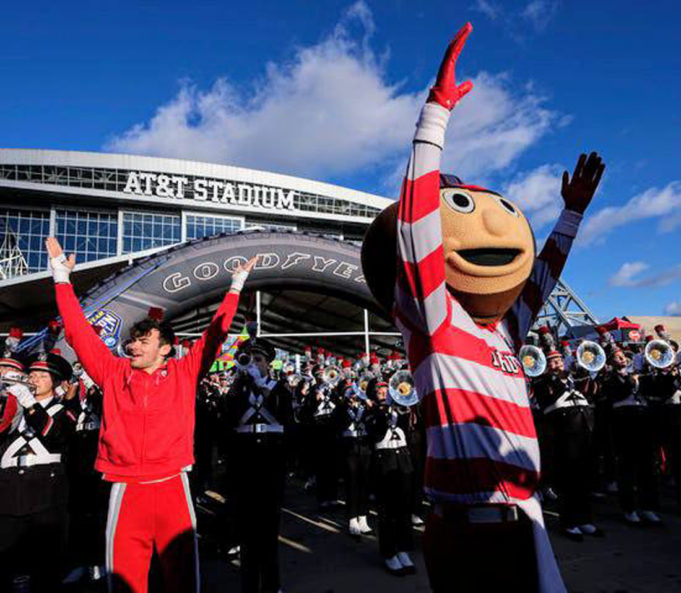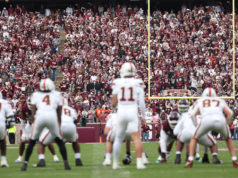In any other year, we’d be discussing the merits of the newly crowned national champion and the game that delivered them there. Thanks to the expansion of the College Football Playoff, many of us spent Thursday through Monday watching meaningful — and competitive — college and professional playoff games. Last week, I asserted that if both now-semipro games yielded a mean win differential of 15 points or fewer, that would be greatness. Thursday’s and Friday’s spats averaged an 8.5-point difference, one of the best in the history of the playoff, and it was actually closer than the numbers suggest.
I’ll give myself a casual pat on the back for picking both winners correctly in last week’s rundown, but the games themselves developed differently than expected.
It’s unclear whether Notre Dame was overvalued or Penn State under, or both, but it was like watching the same team play each other. Neither the Fighting Irish nor the Nittany Lions were able to produce much offense. Other than impressive line play and what we’ve come to know as classic smashmouth football, there wasn’t a game-changing pass catcher to be found. State clawed themselves to a 10-0 lead before the Irish were able to notch a 3 before halftime, forcing the green and gold to play catchup, and they did, scoring their first touchdown to open the second half.
Notre Dame and PSU played tit for tat moving forward, neither team able to retain a lead, knotting at 17 and 24, never letting an advantage linger long enough to extend it. The Lions were in position to either drive for a last-second kick or bleed the clock for overtime when an unthinkable interception in their own territory with 33 seconds remaining handed the Irish a new lease on life, their season, and true relevance. Despite their enviable status as a wealthy and conference-less independent who has earned $20 million alone this playoff season, the Irish as an actual contender hasn’t been a reality for some time. The green and gold return to the title game for the first time since the BCS’ penultimate season, when they were chased off the field by Nick Saban’s Crimson Tide 42-14. That had been their most recent appearance to play for it all since the school’s last title in 1988, when Hall of Fame coach Lou Holtz completed a perfect season by beating the third-ranked and previously undefeated West Virginia Mountaineers.
After such a close Thursday game, I had minimal expectations for the Cotton Bowl, but Texas didn’t upset their formula of fighting for nail biters. Ohio State, as they did against Oregon, struck early and put the Longhorns on their spurs from the get. When it seemed UT had finally McConaughey’d themselves into an alright, alright situation before half, the Buckeyes responded with a one-play 75-yard screen pass for an easy touchdown. After the break, the game progressed in a grind, similar to how the previous day’s Orange Bowl had. Texas could never gain a lead but were never more than a possession behind and constantly threatening. Longhorn QB Quinn Ewers — despite being a lightning rod for criticism — played with grit and precision, even channeling a Baker Mayfield-ish vibe at times, running with mojo and risking his own safety on critical downs.
The Longhorns fought to the Ohio State 8 yard-line with just over two minutes remaining, trailing by a touchdown, when disaster struck. On fourth and goal, Ewers was strip-sacked by his former Buckeye roommate, who scooped and scored the ball for a 92-yard touchdown, producing the second Longhorn semifinal loss in as many years. The 28-14 final is not indicative of a game that could have easily advanced to overtime, but the UT offense proved too inconsistent to deliver them to extra time or a victory.
This weekend marks a huge victory for the College Football Playoff, expansion, and the semifinals. After a first decade in which three playoff games per year might produce one close contest, we’ve now enjoyed three consecutive years in which the final four was almost as good as the previous year’s. TCU’s 6-point victory over Michigan combined with Georgia’s 1-point win against Ohio State is a leading contender, and the Wolverines’ overtime advancement past Alabama plus Texas’ season ending in their opponent’s red zone against the Huskies last season also makes a case for the mantle spot. I’d seed this season a solid third and would watch it again when I’m jonesing in the dead of summer.
It’s hard to surmise how to feel about the expanded playoffs right now. The first-round games were a wash, the second round were all “upsets,” and now we have the 7th and 8th seeds facing off for everything. While it feels somewhat surprising to be previewing these teams in the national title game, considering neither won a conference, it really shouldn’t. This new and longer format favors defense, and in terms of stats, Ohio State and Notre Dame have the first and second scoring defenses, respectively. Texas is fourth in scoring defense, and Penn State eighth. Indiana and Tennessee were the only other playoff qualifiers with Top 10 scoring defenses, and they just suffered the misfortune of running into better ones in the first round.
So, this brings us to the elephant in the room (not Alabama, who are on a losing streak), but the proverbial one. Amateur college football is/was/has been finished, and the league is truly now just a teenage pre-salary-cap NFL. For example: Ewers is reportedly being offered as much as $6 million to transfer and play another season somewhere else — Niners QB Brock Purdy didn’t even make $1 million in salary this season. But the allure of college football used to be the unabashed chaos and subjectivity. Every game really mattered, and it doesn’t anymore. David had the chance to be perfect and slay Goliath, or, if nothing else, David could bestow a nasty cut that would eventually infect Goliath and kill them months later. Granted, it’s not that there weren’t shenanigans with paying players before, but the clandestine cash-in-a-McDonald’s-bag nature of it was part of the charm.
Without expansion, it’s difficult to predict who we’d be watching this weekend, but it surely wouldn’t be Ohio State. More teams included is less comment-section drama. If your team couldn’t make a field of 12, they probably weren’t really contenders, because only about six of these teams actually were. We’re also treated to the second consecutive SEC-less title game, and for probably the first time in the history of college football, the competing teams have a combined three losses, which is just weird.
Don’t be confused. I’m not claiming to know how to fix college football, that players shouldn’t be paid, or that fewer games are favorable. But as the sport has become even more of an arms race, it’s starting to feel cheap, as gaudy expensive things often do. The product on the field is not worse — if anything, this year has proven that the ability to pay these players a salary has leveled the field away from nauseating SEC domination. But it doesn’t feel as innocent as it used to, and in the words of Andy from The Office: “I wish there was a way to know you’re in the good ol’ days before you’ve actually left them.”












